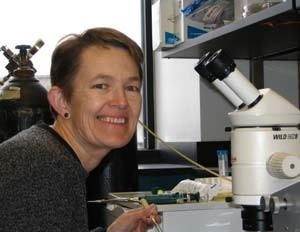For the last week of March and as the end of our mini-series, we are pleased to present Prof. Janet Heasman. She has dedicated her career to vertebrate development using Xenopus laevis as a model.
Biography
Janet Heasman was born in Hartlepool, England (1,2). She attended University College Hospital Medical School in London and in the second year, she took an intercalated BSc degree in J.Z. Young’s Anatomy department where she met her husband, Christopher Wylie (1,2) . Janet succeeded her BCs degree in 1974 and after a year of studying clinical medicine, she did a year of research and teaching with Christopher at Dartmouth College in New Hampshire. This year was decisive because it was then when she chose to do her career in academic research and no more in the clinic (1,2).
They together returned to London and she registered for a PhD. She then became a lecturer and, later, a senior lecturer at St George’s Hospital Medical School. She and her husband worked there for 12 years. During this time, Janet and Christopher had their first child. Later, they will have 3 more (2).

They later decided to move to the USA and were employed at the University of Minnesota. After 6 years they moved to Cincinnati Children’s Hospital Research Foundation where Janet held the position of Professor in the Developmental Biology Division until 2012 when she retired (1,2).
Her contribution to Xenopus science
During her career, Janet focused on embryonic stem cell, gene expression, cell type and cleavage, with the majority of her papers about Xenopus embryos (3).
Two of the articles she has written have been cited over 800 times. These are “Morpholino Oligos: Making Sense of Antisense?” and “Overexpression of Cadherins and Underexpression of β-Catenin Inhibit Dorsal Mesoderm Induction in Early Xenopus Embryos”.
Her article “Morpholino Oligos: Making Sense of Antisense?” explains the morpholino oligos method to study gene function. This method induces knockout in a target mRNA. In biology, a knockout is a total gene inactivation in order to study the effects of the gene. In research, making knockout allows biologists to visualise in which pathways the gene is involved.
The principle of the morpholino oligos method is to introduce a small RNA sequence (called oligo) that is complementary to a part of the target mRNA. The oligo function is to prevent ribosomes from binding. In this way, the mRNA is intact but is hidden by the oligo and is not translated into protein by the ribosomes (4).
Morpholino oligos can also be used to partially restore mutated protein activity. This is the case, for example, when a mutation in the DNA induces an amino acid change in the resulting protein. With morpholino oligo and by playing on complementarity, it is possible to make the mutated part of the protein invisible to the ribosome while preserving the rest of the translation. Thus, the resulting protein is shorter than the normal protein but the function is partially restored (6).

A second major article “Overexpression of Cadherins and Underexpression of β-Catenin Inhibit Dorsal Mesoderm Induction in Early Xenopus Embryos” explains the role of the cadherin-catenin complexes in cell-cell adhesion and in signaling pathways in Xenopus embryos. Experiences of interference of this complex have been made and results show changes in development and a defective neurogenesis (5).
The cadherin-catenin complex is a group of proteins involved in cellular adhesion and aggregation. It is essential for the cohesion of the embryo and for its appropriate development (5).
Conclusion
Prof. Janet Heasman’s work has had a significant impact on the understanding of embryonic development and in particular on the development of Xenopus laevis embryos.
Even today, women are not always as highly esteemed as men in the scientific world. Janet, as well as many other women in science, successfully managed to combine her work as a scientist and as a mother.
References
- Janet Heasman – Personal Page [Internet]. [cited 2023 Mar 27]. Available from: https://www.xenbase.org/entry/community/person.do?method=display&personId=733
- Thompson H. Bias against women in higher scientific positions? J Cell Sci. 2004 Apr 1;117(9):1618–1618.
- Janet Heasman: H-index & Awards – Academic Profile [Internet]. Research.com. [cited 2023 Mar 27]. Available from: https://research.com/u/janet-heasman
- Heasman J. Morpholino Oligos: Making Sense of Antisense? Dev Biol. 2002 Mar;243(2):209–14.
- Heasman J, Gumbiner B, McCrea P, Kintner BC, Wylie’ C. Overexpression of Cadherins and Underexpression of B-Catenin Inhibit Dorsal Mesoderm Induction in Early Xenopus Embryos.
- Du L, Gatti RA. Potential therapeutic applications of antisense morpholino oligonucleotides in modulation of splicing in primary immunodeficiency diseases. J Immunol Methods. 2011 Feb 28;365(1):1–7.
First image : Janet Heasman – Personal Page [Internet]. [cited 2023 Mar 27]. Available from: https://www.xenbase.org/entry/community/person.do?method=display&personId=733



